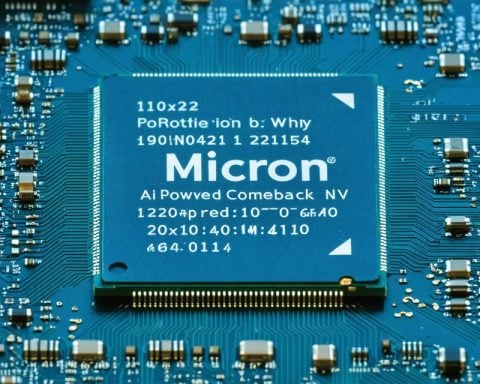- The ProShares Ultra Semiconductors ETF (NYSE:USD) is a key player, closely tracking the Dow Jones U.S. Semiconductor Index.
- Strong performance: The ETF boasts an impressive five-year return of 702.16%, highlighting the semiconductor sector’s importance.
- Semiconductors are crucial for innovations in industries like smartphones and self-driving vehicles, with leaders such as QUALCOMM driving progress.
- Economic challenges include rising inflation and the looming threat of stagflation, complicating the investment landscape.
- Geopolitical tensions and efficiency-driven layoffs further add to the sector’s volatility.
- Despite uncertainties, investors maintain cautious optimism, pondering whether to adapt their strategies in light of active ETFs gaining prominence.
- The strategic question remains: is it time for a decisive pivot in investment strategies or to continue riding the semiconductor wave?
Amid the chatter of bustling markets, the realm of semiconductors stands at a strategic edge, bolstered by the ProShares Ultra Semiconductors ETF (NYSE:USD). As the ETF mirrors the performance of the Dow Jones U.S. Semiconductor Index, it reflects a dynamic dance with the intricacies of technology and innovation, offering investors a forecast of transformations to come.
Stretching back five years, this ETF’s returns have soared to breathtaking heights—702.16% to be exact. Such performance underlines the sector’s pivotal role in transforming industries from smartphones to self-driving vehicles, all under the leadership of key players like QUALCOMM. Investing here feels like riding a relentless wave of progress, powered by innovation at every corner.
Yet, while semiconductors bask in their success, a storm brews on the horizon. Inflation remains persistent, reflecting a landscape where economic expectations shift like desert sands. Consumer prices have nudged higher, revealing core inflation’s stubborn heartbeat, exceeding the central bank’s hopeful targets. Throw into this mix the nightmare scenario of stagflation—where high inflation pairs uncomfortably with stagnant growth—and the picture becomes murky.
The specter of stagflation, once dismissed, has returned with unnerving confidence. Policies curtailing consumer demand and geopolitical tensions add fuel to this possible economic firestorm. Meanwhile, layoffs orchestrated by the new billion-dollar efficiency drive add an unpredictable twist to the scenario. Yet despite these uncertainties, investors surmise the trade tensions as minimal, clinging to cautious optimism in equities.
As portfolios evolve and active ETFs claim a larger stake, the unfolding narrative invites investors to contemplate: Is now the moment to pivot with careful foresight or stand firm in the rising tides of semiconductors? In the grand tapestry of financial markets, this remains the puzzle to ponder.
Unlocking the Semiconductor Investment Puzzle: What to Know Now
Understanding the Semiconductor ETF Landscape
The ProShares Ultra Semiconductors ETF (NYSE:USD) is a leveraged exchange-traded fund that seeks two times the daily performance of the Dow Jones U.S. Semiconductor Index. This ETF provides investors with exponential exposure to the semiconductor industry’s movements, making it a high-risk, high-reward vehicle suitable for short-term trading, not for long-term holding due to volatility.
How-To Steps & Life Hacks for Investing in Semiconductor ETFs
1. Assess Risk Tolerance: Understand the volatility associated with leveraged ETFs. They are best for investors looking for short-term exposure.
2. Short-Term Monitoring: Continuously monitor market conditions and semiconductor sector news to timely capitalize or exit investments.
3. Diversification: Incorporate semiconductor ETFs as part of a broader portfolio, balancing them with more stable assets to mitigate risk.
Real-World Use Cases
Semiconductors are crucial in smartphones, automotive sensors, AI applications, and computing devices. As the adoption of 5G, AI, and IoT expands, the demand for advanced semiconductors will likely increase, benefiting ETFs like ProShares Ultra Semiconductors.
Market Forecasts & Industry Trends
The semiconductor industry is estimated to grow at a compound annual growth rate (CAGR) of over 8% from 2023 to 2028, driven by demand in AI, IoT, and automotive sectors (source: McKinsey & Company). Policies supporting technology innovation and manufacturing are expected to keep demand robust.
Reviews & Comparisons
Compared to other semiconductor ETFs, the ProShares Ultra Semiconductors ETF offers leveraged exposure, contrasting with non-leveraged options like the VanEck Vectors Semiconductor ETF (SMH) and iShares Semiconductor ETF (SOXX), which provide general sector exposure.
Controversies & Limitations
While offering amplified gains, leveraged ETFs carry high volatility and decay, making them unsuitable for long-term strategies. Investors risk significant losses during market downturns due to leveraged compounding effects.
Features, Specs & Pricing
– Leverage: 2x the daily change in the Dow Jones U.S. Semiconductor Index
– Expense Ratio: Approximately 0.95%
– Efficiency: Suitable for intraday or short-term trading strategies
Security & Sustainability
The fund’s investments directly reflect the semiconductor industry’s sustainability efforts. Increasingly, semiconductor companies are adopting sustainable practices to reduce environmental impact, potentially enhancing long-term investment appeal.
Insights & Predictions
Geopolitical factors, such as U.S.-China tensions, could introduce unpredictability into supply chains and affect semiconductor stock performance. However, innovations and domestic manufacturing initiatives may counterbalance these risks.
Tutorials & Compatibility
Leverage platforms like Vanguard or Fidelity to track and trade ETFs. Some platforms offer educational tools to understand leveraged investments better.
Pros & Cons Overview
Pros:
– High potential returns
– Provides unmatched exposure to the dynamic semiconductor sector
Cons:
– High volatility and risk
– Unsuitable for long-term hold due to leveraged nature
Actionable Recommendations
1. Stay Updated: Monitor industry trends and government policies impacting the semiconductor sector.
2. Diversify: Use ETFs like ProShares Ultra Semiconductors strategically within a diversified portfolio.
3. Risk Management: Employ stop-loss orders to manage potential steep losses in volatile markets.
For further investment insights and tools, consider resources from major investment platforms like Vanguard or Fidelity.
Use this guidance to navigate the semiconductor ETF market intelligently and optimize your investment strategy confidently in a rapidly evolving landscape.
























